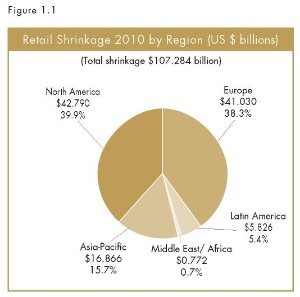Shrink Down 5.6 percent, to $107.3 Billion Worldwide: Study
Shrink decreased 6.8 percent in U.S. over the past year, but more than one-third of American retailers still experienced higher attempted or actual theft, according to a new study by the Centre for Retail Research, Nottingham, UK.
According to the fourth edition of the “Global Retail Theft Barometer,” sponsored by an independent grant from Checkpoint Systems, global retail theft totaled $107.3 billion in 2010, representing a 5.6 percent decrease from the prior year (6.8 percent in the U.S.).
 "Even with the shrink decrease, retail crime cost the average family in the 42 countries surveyed an extra $186 on their shopping bill," said professor Joshua Bamfield, director of the Centre for Retail Research and author of the study. "In the U.S., that number was $422.68, a phenomenal figure."
"Even with the shrink decrease, retail crime cost the average family in the 42 countries surveyed an extra $186 on their shopping bill," said professor Joshua Bamfield, director of the Centre for Retail Research and author of the study. "In the U.S., that number was $422.68, a phenomenal figure."
The study monitored the costs of shrink (loss from shoplifting/employee crimes and administrative errors) in the global retail industry between July 2009 and June 2010, and found that shrink decreased in all regions surveyed. While the biggest decrease was in North America, the proportion of global retailers that reported increased actual or attempted shoplifting in 2010 was 31.1 percent (36.7 percent in the U.S.).
The 2010 study also found that retailers increased their spending on loss prevention and security by 9.7 percent over 2009, to $26.8 billion globally; in the U.S. the increase in loss prevention spending over 2009 amounted to 12.5 percent.
"The correlation between increased security spending and a global 5.6 percent decrease in theft is very significant," said Bamfield. "It highlights the importance of continued advancement and improvement of loss prevention programs, as reducing theft is key to the success and growth of retailers' businesses."
"In 2008 at the start of the economic downturn, the temptation for retailers was to reduce their loss prevention spending," added Rob van der Merwe, chairman, president and CEO of Thorofare, N.J.-based Checkpoint Systems. "This typically leads to an increase in shrink and that is what we saw with the 2009 Theft Barometer study. Retailers quickly realized the need to correct this trend and began to invest in smart deployments that could be quickly implemented with high ROIs, such as increased protection of high-theft merchandise, and more employee training and store audits. This resulted in a short-term win and a decrease in shrink.”
Shrink cost retailers $107.3 billion during the study period, representing 1.36 percent of global retail sales, down from 1.43 percent the previous year, the study found. The country with the highest rates of shrink as a percentage of sales was India (2.72 percent of retail sales). The lowest rate of shrink was found in Taiwan (0.87 percent). The US rate was 1.50 percent.
While shrink is down overall, some of the most stolen items have suffered increased shrink since last year, including children's wear, outerwear, shaving products, luxury cooked meats, and infant formula. Customer theft, including shoplifting and organized retail crime caused the greatest shrink loss in most countries at 42.4 percent of shrink, followed by employee theft at 35.3 percent.
North American retailers are different from the rest of the world in regarding employee theft as their greatest shrink problem, causing 43.7 percent of shrink. The second largest source was shoplifting at 35 percent. Some 47.8 percent of U.S. retailers reported that they experienced increased losses from organized retail crime (ORC). The highest average rates of shrink were in cosmetics/perfume/beauty supply/pharmacy (1.88 percent), followed by auto parts/hardware/building materials retail (1.75 percent), and apparel/clothing/fashion and accessories (1.69 percent).
Started in 2001 in Europe and expanded in 2007 globally, the Global Retail Theft Barometer is an annual survey conducted by the Centre for Retail Research, and covers key trends in retail shrink and crime in 42 countries and regions across the world, including the U.S., China, India, Europe, Japan, and Australia. Russia is included for the first time this year.
The report has been prepared from a confidential details provided by 1,103 of the largest retailers with combined sales of $873.8 billion, representing a cross-section of countries and retail vertical markets.
The fourth edition of the study was produced by professor Joshua Bamfield, director of the Centre for Retail Research (www.retailresearch.org) with the cooperation of Checkpoint Systems, Inc. The CRR is an independent organization providing research and consultancy for the retail sector dealing with the changing face of retailing and focusing on retail fraud and crime
